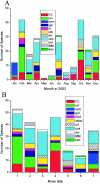Mycobacterial ecology of the Rio Grande
- PMID: 16204480
- PMCID: PMC1265914
- DOI: 10.1128/AEM.71.10.5719-5727.2005
Mycobacterial ecology of the Rio Grande
Abstract
This is the first study to characterize the environmental conditions which contribute to the presence and proliferation of environmental mycobacteria in a major freshwater river. Over 20 different species of environmental mycobacteria were isolated, including the pathogenic M. avium and M. kansasii. Species of the rapidly growing M. fortuitum complex were the most commonly isolated mycobacteria, and one-third of all isolates were not identified at the species level, even by 16S sequencing. PCR restriction analysis of the hsp65 gene was more accurate and rapid than biochemical tests and as accurate as yet less expensive than 16S sequencing, showing great promise as a new tool for species identification of environmentally isolated mycobacteria. Total environmental mycobacteria counts positively correlated with coliform and Escherichia coli counts and negatively correlated with chemical toxicity and water temperature. Environmental mycobacteria can survive in the alkaline conditions of the river despite previous reports that especially acidic conditions favor their presence. A representative river isolate (M. fortuitum) survived better than E. coli O157:H7 at pHs below 7 and above 8 in nutrient broth. The river strain also retained viability at 8 ppm of free chlorine, while E. coli was eliminated at 2 ppm and above. Thus, in vitro studies support environmental observations that a variety of extreme conditions favor the hardy environmental mycobacteria.
Figures




References
-
- American Thoracic Society. 1997. Diagnosis and treatment of disease caused by nontuberculous mycobacteria. Official statement of the American Thoracic Society approved by the Board of Directors, March 1997. Medical Section of the American Lung Association. Am. J. Respir. Crit. Care Med. 156:S1-25. - PubMed
-
- Aronson, T., A. Holtzman, N. Glover, M. Boian, S. Froman, O. G. Berlin, H. Hill, and G. Stelma, Jr. 1999. Comparison of large restriction fragments of Mycobacterium avium isolates recovered from AIDS and non-AIDS patients with those of isolates from potable water. J. Clin. Microbiol. 37:1008-1012. - PMC - PubMed
-
- Botsford, J. L. 2002. A comparison of ecotoxicological tests. Altern. Lab. Anim. 30:539-550. - PubMed
Publication types
MeSH terms
Substances
Grants and funding
LinkOut - more resources
Full Text Sources
Research Materials

